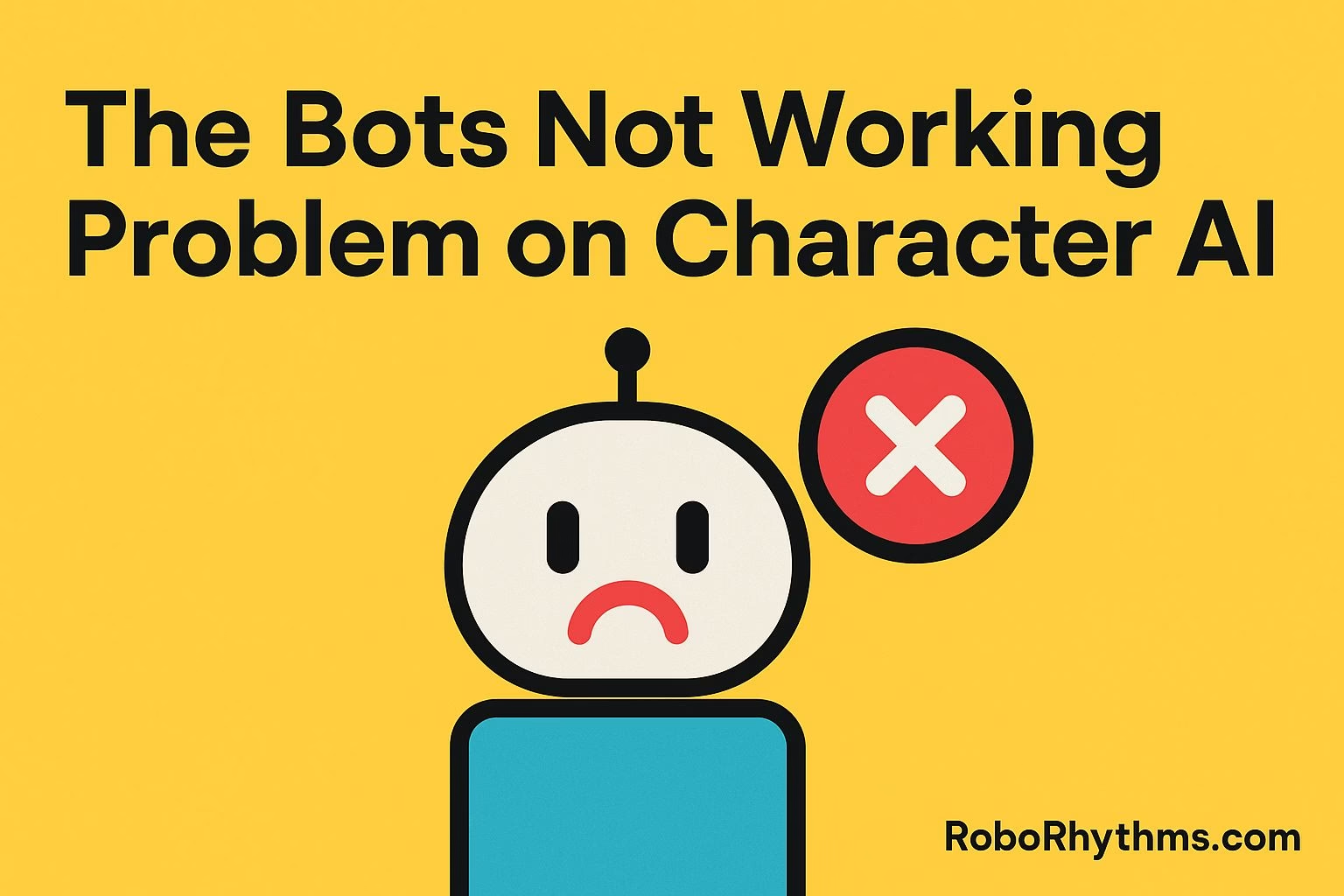The Bots Not Working Problem on Character AI
Anyone using Character AI has noticed the same frustrating trend: bots and new models work well for a short time, then suddenly begin to decline.
Conversations that once felt creative and alive start to sound repetitive or out of character. Updates sometimes bring back that spark, but the improvements rarely last.
This decline is not just random. It connects to a known issue in large language models called LLM decay, also referred to as model drift.
Over time, every LLM faces this challenge, and Character AI is no exception. While the term might sound technical, the effects are easy to see.
Bots become less creative, less consistent, and less enjoyable to interact with.
Several factors feed into this decay. Data drift occurs when user inputs differ too much from the data the model was trained on.
Model collapse happens when models are trained on outputs from other AI systems, creating a kind of digital inbreeding.
Reinforcement training can also play a role, especially when likes and dislikes push bots toward bland, repetitive responses. Even cost-cutting influences the quality of training, leading to weaker results.
The good news is that decay does not mean doom. With regular retraining, better monitoring, and higher quality non-AI data, Character AI could restore stability to its bots.
But until that happens, users will continue to face the “bots not working” problem. RoboRhythms.com will keep following these changes and examining why popular AI tools lose their edge so quickly.
Quick Summary
Character AI bots often decline in quality after launch due to LLM decay.
This includes:
Data drift when user inputs differ from training data
Model collapse from AI training on AI-generated outputs
Reinforcement training loops that reward bland responses
Cost cutting that reduces training quality and retraining frequency
Solutions that could help:
Scheduled retraining with high quality, non-AI content
Ongoing monitoring of performance issues
Reinforcement design that values creativity and in-character replies
Stronger investment in infrastructure and training data
Transparency with users about steps taken to manage decay
These measures won’t erase decay but can slow it down and keep bots reliable for longer.
What Is LLM Decay in Character AI
LLM decay, sometimes called model drift, describes the gradual decline in how well a large language model performs.
For Character AI users, this explains why bots start strong but become less engaging after some time.
The quality of conversations drops because the model no longer responds the way it was designed to.
This decay can show up in different ways. A bot that once gave detailed and in-character answers might shift toward shorter, generic replies.
Creativity drops as the model falls back on safe patterns instead of exploring unique responses. Some users even notice the same words or phrases repeating more often, a clear sign of the model struggling.
The issue comes from how models learn and adapt. Every interaction, every rating, and every update shifts the balance of the model’s responses.
Over time, these small changes add up, pulling the bots away from the quality they had at launch. Without regular retraining, this process accelerates until the decline becomes noticeable.
For users, the result is a frustrating experience. Bots no longer feel fresh or fun to talk to, and the whole point of Character AI, immersive, engaging conversations, gets lost. That is why understanding LLM decay is key to explaining the “bots not working” problem.
How Data Drift Affects Character AI Bots
Data drift is one of the main drivers of LLM decay. It happens when the input data, what users type, looks very different from the data the model was trained on.
In simple terms, the bot was trained on one style of text, but users are giving it something else.
On Character AI, this can happen quickly. The way people roleplay or interact with bots is not always reflected in the original training data.
As those differences build, the model struggles to keep up. That’s when responses start to feel off, breaking immersion.
Another issue is the type of feedback users give. When the platform introduced likes and dislikes for bot responses, it created a new feedback loop.
If users dislike creative or lengthy answers, the model gets trained to avoid them, even if those answers were more in character. Over time, this drifts the bots further from what people actually want.
Data drift is not unique to Character AI; it affects all LLMs. But because the platform depends so heavily on personality-driven interactions, the effects are more obvious.
Users expect consistency, and even small drifts can break the illusion that makes the bots enjoyable.
Model Collapse in Character AI Bots
Model collapse is another major reason Character AI bots lose quality. This happens when new models are trained on outputs generated by other AI systems instead of human-created content.
The result is similar to digital inbreeding; the variety and richness of responses shrink over time.
When collapse sets in, bots sound less original. Instead of drawing from diverse sources, they recycle patterns already created by other models.
For users, that means conversations feel predictable, repetitive, and less authentic. The distinct personalities that once made bots fun to use slowly blur into a bland sameness.
This problem also explains why some filters misfire. Since the filter itself works as a separate model, it can overcorrect when trained on too much AI-generated content.
That’s why harmless conversations sometimes get flagged and shut down, breaking immersion for users.
The more AI feeds on AI, the faster the collapse happens. For a platform like Character AI, which thrives on creativity and diversity, this collapse directly hurts the experience.
Preventing it requires careful control over training data to ensure it remains rich, varied, and mostly human-created.
The Role of Reinforcement Training in Character AI
Reinforcement training is meant to make bots better, but it can also make them worse.
On Character AI, this training relies on user feedback, likes, and dislikes attached to bot responses.
While the idea is to guide the model toward what users prefer, the outcome depends entirely on how the feedback is used.
If many users dislike creative, long, or deeply in-character answers, the model starts to avoid them. If short and generic answers receive more likes, those become the default.
Over time, the bots get trained into mediocrity, not excellence. What feels like fine-tuning ends up stripping away the personality that makes them unique.
This training also interacts with other decay factors. Combined with data drift and model collapse, reinforcement training pushes bots further into bland territory.
Instead of improving, updates may only speed up the decline. That’s why users notice bots feeling less alive after new adjustments, even if the intent was to improve them.
For Character AI to benefit from reinforcement training, the process would need tighter control. Good quality content should be rewarded, and users should understand how their feedback shapes the bots.
Without that balance, reinforcement becomes part of the problem instead of the solution.
How Cost Cutting Reduces Character AI Quality
Behind the technical reasons for bot decline, there is also a financial one. Training and maintaining large language models is expensive.
When companies cut costs, quality usually suffers, and Character AI is no exception.
Cheaper training runs often use lower quality data. That means bots learn from sources that are less diverse or even include other AI outputs, which accelerates decay.
Reduced budgets can also mean less frequent retraining, so models are left drifting for longer periods before being updated.
Infrastructure is another hidden cost. Running advanced models at scale requires powerful servers and significant resources.
If a company trims spending on these, users may see slower responses, weaker consistency, and more frequent errors.
Cost-cutting might help balance the books, but it has a direct impact on the user experience.
For a platform where immersion and reliability matter, every shortcut in training or support weakens the very thing that makes the bots appealing.
Solutions to the Bots Not Working Problem
Even though decay is a natural part of how LLMs work, there are clear ways to slow it down and improve quality for Character AI users.
These solutions are already known in the AI field, but they require consistent investment and attention.
One solution is scheduled retraining. Refreshing the models regularly with high quality, non-AI content helps reset them before decay becomes too noticeable.
Alongside that, continuous monitoring of performance ensures issues are caught early instead of after users complain.
Another approach is smarter use of reinforcement training. Encouraging feedback that rewards creativity and in-character responses would help preserve the traits users enjoy.
Right now, feedback loops often train bots into blandness, but with better design, they could do the opposite.
Finally, transparency with the user community would make a difference. Explaining how decay works and showing what steps are being taken to address it would restore trust.
For users who feel powerless when bots decline, knowing their input shapes the outcome could keep the community engaged.
These changes would not eliminate decay, but they would regulate it. For Character AI to stay relevant, the company will need to invest in quality instead of letting costs dictate direction.
Until then, the “bots not working” problem will remain an ongoing struggle.

